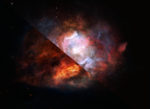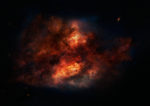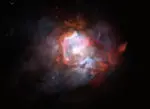ALMA and VLT Find Too Many Massive Stars in Starburst Galaxies, Near and Far
Astronomers using the Atacama Large Millimeter/submillimeter Array (ALMA) and the Very Large Telescope (VLT) have discovered that both, starburst galaxies in the early Universe, and a star-forming region in a nearby galaxy, contain a much higher proportion of massive stars than is found in more peaceful galaxies. These findings challenge current ideas about how galaxies evolved, changing our understanding of cosmic star-formation history and the build-up of chemical elements.
This artist’s impression shows a dusty galaxy in the distant Universe that is forming stars at a rate much higher than does our Milky Way. The new ALMA observations have allowed scientists to lift the veil of dust and see what was previously inaccessible — that such starburst galaxies have an excess of massive stars compared to more peaceful galaxies. Credit: ESO/M. Kornmesser
Probing the distant Universe a team of scientists, led by University of Edinburgh astronomer Zhi-Yu Zhang, used ALMA to investigate the proportion of massive stars in four distant gas-rich starburst galaxies [1]. These galaxies are seen when the Universe was much younger than it is now so the infant galaxies are unlikely to have undergone many previous episodes of star formation, which might otherwise have confused the results. Probing the distant Universe a team of scientists, led by University of Edinburgh astronomer Zhi-Yu Zhang, used the
Zhang and his team developed a new technique — analogous to radiocarbon dating (also known as carbon-14 dating) — to measure the abundances of different types of carbon monoxide in four very distant, dust-shrouded starburst galaxies [2]. They observed the ratio of two types of carbon monoxide containing different isotopes [3].
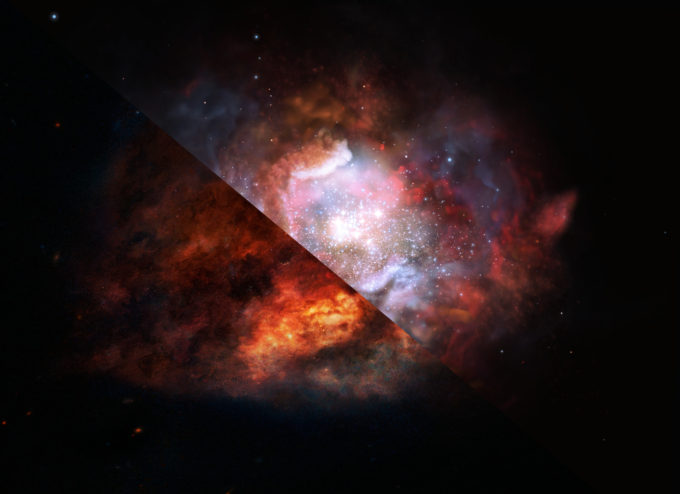
This artist’s impression shows a dusty galaxy in the distant Universe that is forming stars at a rate much higher than in our Milky Way. New ALMA observations have allowed scientists to lift the veil of dust and see what was previously inaccessible — that such starburst galaxies have an excess of massive stars as compared to more peaceful galaxies. Credit: ESO/M. Kornmesser
“Carbon and oxygen isotopes have different origins,” explains Zhang. “18O is produced more in massive stars, and 13C is produced more in low- to intermediate-mass stars.” Thanks to the new technique the team was able to peer through the dust in these galaxies and assess for the first time the masses of their stars.
The mass of a star is the most crucial factor determining how it will evolve. Massive stars shine brilliantly and have short lives and less massive ones, such as the Sun, shine more modestly for billions of years. Knowing the proportions of stars of different masses that are formed in galaxies, therefore, underpins astronomers’ understanding of the formation and evolution of galaxies throughout the history of the Universe. Consequently, it gives us valuable insights about the chemical elements available to form new stars and planets and, ultimately, the number of seed-black-holes that may coalesce to form the supermassive black holes that we see in the centers of many galaxies.
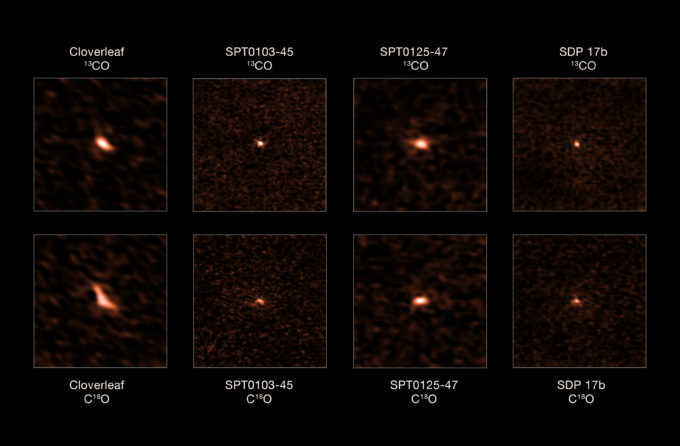
This image shows the four distant starburst galaxies observed by ALMA. The top images depict the 13CO emission from each galaxy, while the bottom ones show their C18O emission. The ratio of these two isotopologues allowed astronomers to determine that these starburst galaxies have an excess of massive stars. Credit: ESO/Zhang et al.; ALMA (ESO/NAOJ/NRAO).
Co-author Donatella Romano from the INAF-Astrophysics and Space Science Observatory in Bologna explains what the team found: “The ratio of 18O to 13C was about 10 times higher in these starburst galaxies in the early Universe than it is in galaxies such as the Milky Way, meaning that there is a much higher proportion of massive stars within these starburst galaxies.”
The ALMA finding is corroborated by another discovery in the local Universe. A team led by Fabian Schneider of the University of Oxford, UK, made spectroscopic measurements with ESO’s Very Large Telescope of 800 stars in the gigantic star-forming region 30 Doradus in the Large Magellanic Cloud in order to investigate the overall distribution of stellar ages and initial masses [4].
Schneider explained, “We found around 30% more stars with masses more than 30 times that of the Sun than expected, and about 70% more than expected above 60 solar masses. Our results challenge the previously predicted 150 solar mass limit for the maximum birth mass of stars and even suggest that stars could have birth masses up to 300 solar masses!”
Rob Ivison, a co-author of the new ALMA paper, concludes: “Our findings lead us to question our understanding of cosmic history. Astronomers building models of the Universe must now go back to the drawing board, with yet more sophistication required.”
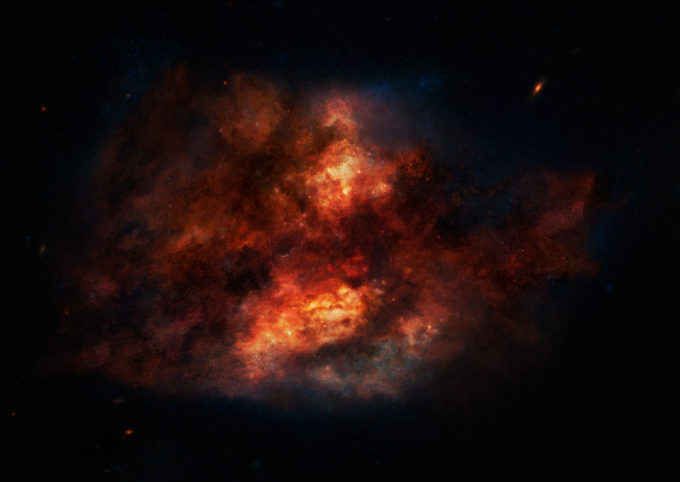
Galaxies in the distant Universe are seen during their youth and therefore have relatively short and uneventful star formation histories. This makes them an ideal laboratory to study the earliest epochs of star formation. But at a price — they are often enshrouded by obscuring dust that hampers the correct interpretation of the observations. Credit: ESO/M. Kornmesser
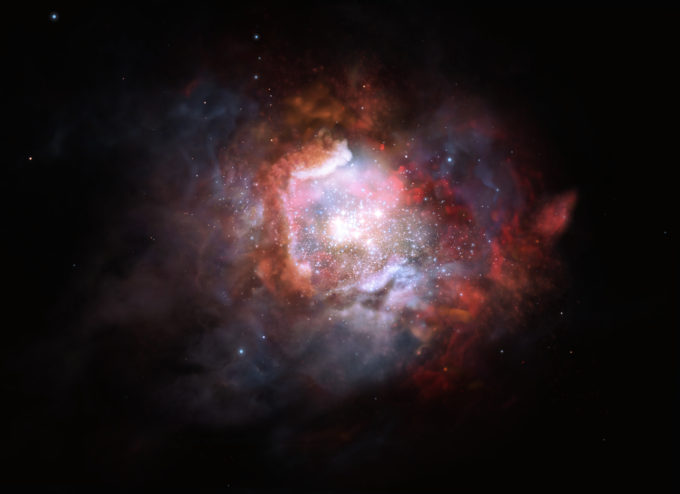
This kind of galaxy is typically forming stars at such a high rate that astronomers often refer to them as “starbursts”. They can form up to 1000 times more stars per year, compared to the Milky Way. Thanks to the unique capabilities of ALMA, astronomers have been able to measure the proportion of high-mass stars in such starburst galaxies. Credit: ESO/M. Kornmesser
Notes
[1] Starburst galaxies are galaxies that are undergoing an episode of very intense star formation. The rate at which they form new stars can be 100 times or more the rate in our own galaxy, the Milky Way. Massive stars in these galaxies produce ionizing radiation, stellar outflows, and supernova explosions, which significantly influence the dynamical and chemical evolution of the medium around them. Studying the mass distribution of stars in these galaxies can tell us more about their own evolution, and also the evolution of the Universe more generally.
[2] The radiocarbon dating method is used for determining the age of an object containing organic material. By measuring the amount of 14C, which is a radioactive isotope whose abundance continuously decreases, one can calculate when the animal or plant died. The isotopes used in the ALMA study, 13C and 18O, are stable and their abundances continuously increase during the lifetime of a galaxy, being synthesized by thermal nuclear fusion reactions inside stars.
[3] These different forms of the molecule are called isotopologues and they differ in the number of neutrons they can have. The carbon monoxide molecules used in this study are an example of such molecular species because a stable carbon isotope can have either 12 or 13 nucleons in its nucleus, and a stable oxygen isotope can have either 16, 17, or 18 nucleons.
[4] Schneider et al. made spectroscopic observations of individual stars in 30 Doradus, a star-forming region in the nearby Large Magellanic Cloud, using the Fibre Large Array Multi-Element Spectrograph (FLAMES) on the Very Large Telescope (VLT). This study was one of the first to be carried out that has been detailed enough to show that the Universe is able to produce star-forming regions with different mass distributions from that in the Milky Way.
More information
The ALMA results are published in a paper entitled “Stellar populations dominated by massive stars in dusty starburst galaxies across cosmic time” that will appear in Nature on 4 June 2018. The VLT results are published in a paper entitled “An excess of massive stars in the local 30 Doradus starburst”, which has been published in Science on 5 January 2018.
The ALMA team is composed of Z. Zhang (Institute for Astronomy, University of Edinburgh, Edinburgh, UK; European Southern Observatory, Garching bei München, Germany), D. Romano (INAF, Astrophysics and Space Science Observatory, Bologna, Italy), R. J. Ivison (European Southern Observatory, Garching bei München, Germany; Institute for Astronomy, University of Edinburgh, Edinburgh, UK), P .P. Papadopoulos (Department of Physics, Aristotle University of Thessaloniki, Thessaloniki, Greece; Research Center for Astronomy, Academy of Athens, Athens, Greece;) and F. Matteucci (Trieste University; INAF, Osservatorio Astronomico di Trieste; INFN, Sezione di Trieste, Trieste, Italy)
The VLT team is composed of: F. R. N. Schneider ( Department of Physics, University of Oxford, UK), H. Sana (Institute of Astrophysics, KU Leuven, Belgium), C. J. Evans ( UK Astronomy Technology Centre, Royal Observatory Edinburgh, Edinburgh, UK), J. M. Bestenlehner (Max-Planck-Institut für Astronomie, Heidelberg, Germany; Department of Physics and Astronomy, University of Sheffield, UK), N. Castro (Department of Astronomy, University of Michigan, USA), L. Fossati (Austrian Academy of Sciences, Space Research Institute, Graz, Austria), G. Gräfener (Argelander-Institut für Astronomie der Universität Bonn, Germany), N. Langer (Argelander-Institut für Astronomie der Universität Bonn, Germany), O. H. Ramírez-Agudelo (UK Astronomy Technology Centre, Royal Observatory Edinburgh, Edinburgh, UK), C. Sabín-Sanjulián (Departamento de Física y Astronomía, Universidad de La Serena, Chile), S. Simón-Díaz (Instituto de Astrofísica de Canarias, Tenerife, Spain; Departamento de Astrofísica, Universidad de La Laguna, Tenerife, Spain), F. Tramper (European Space Astronomy Centre, Madrid, Spain), P. A. Crowther (Department of Physics and Astronomy, University of Sheffield, UK), A. de Koter (Astronomical Institute Anton Pannekoek, Amsterdam University, Netherlands; Institute of Astrophysics, KU Leuven, Belgium), S. E. de Mink (Astronomical Institute Anton Pannekoek, Amsterdam University, Netherlands), P. L. Dufton (Astrophysics Research Centre, School of Mathematics and Physics, Queen’s University Belfast, Northern Ireland, UK), M. Garcia (Centro de Astrobiología, CSIC-INTA, Madrid, Spain), M. Gieles (Department of Physics, Faculty of Engineering and Physical Sciences, University of Surrey, UK), V. Hénault-Brunet (National Research Council, Herzberg Astronomy and Astrophysics, Canada; Department of Astrophysics/Institute for Mathematics, Astrophysics and Particle Physics, Radboud University, Netherlands), A. Herrero (Departamento de Física y Astronomía, Universidad de La Serena, Chile), S. Simón-Díaz (Instituto de Astrofísica de Canarias, Tenerife, Spain; Departamento de Astrofísica, Universidad de La Laguna, Tenerife, Spain), R. G. Izzard (Department of Physics, Faculty of Engineering and Physical Sciences, University of Surrey, UK; Institute of Astronomy, The Observatories, Cambridge, UK), V. Kalari (Departamento de Astronomía, Universidad de Chile, Santiago, Chile), D. J. Lennon (European Space Astronomy Centre, Madrid, Spain), J. Maíz Apellániz (Centro de Astrobiología, CSIC–INTA, European Space Astronomy Centre campus, Villanueva de la Cañada, Spain), N. Markova (Institute of Astronomy with National Astronomical Observatory, Bulgarian Academy of Sciences, Smolyan, Bulgaria), F. Najarro (Centro de Astrobiología, CSIC-INTA, Madrid, Spain), Ph. Podsiadlowski (Department of Physics, University of Oxford, UK; Argelander-Institut für Astronomie der Universität Bonn, Germany), J. Puls (Ludwig-Maximilians-Universität München, Germany), W. D. Taylor (UK Astronomy Technology Centre, Royal Observatory Edinburgh, Edinburgh, UK), J. Th. van Loon (Lennard-Jones Laboratories, Keele University, Staffordshire, UK), J. S. Vink (Armagh Observatory, Northern Ireland, UK) and C. Norman (Johns Hopkins University, Baltimore, USA; Space Telescope Science Institute, Baltimore, USA).
The Atacama Large Millimeter/submillimeter Array (ALMA), an international astronomy facility, is a partnership of the European Organisation for Astronomical Research in the Southern Hemisphere (ESO), the U.S. National Science Foundation (NSF) and the National Institutes of Natural Sciences (NINS) of Japan in cooperation with the Republic of Chile. ALMA is funded by ESO on behalf of its Member States, by NSF in cooperation with the National Research Council of Canada (NRC) and the Ministry of Science and Technology (MOST) in Taiwan and by NINS in cooperation with the Academia Sinica (AS) in Taiwan and the Korea Astronomy and Space Science Institute (KASI).
ALMA construction and operations are led by ESO on behalf of its Member States; by the National Radio Astronomy Observatory (NRAO), managed by Associated Universities, Inc. (AUI), on behalf of North America; and by the National Astronomical Observatory of Japan (NAOJ) on behalf of East Asia. The Joint ALMA Observatory (JAO) provides the unified leadership and management of the construction, commissioning and operation of ALMA.
Contacts
-
Zhi-Yu Zhang
University of Edinburgh and ESO, Garching bei München, GermanyPhone: +49 89 32 00 69 10Email: [email protected] -
Fabian Schneider
Department of Physics — University of Oxford, Oxford, United KingdomPhone: +44 18 65 28 36 97Email: [email protected] -
Nicolás Lira
Education and Public Outreach OfficerJoint ALMA Observatory, Santiago - ChilePhone: +56 2 2467 6519Cel: +56 9 9445 7726Email: [email protected] -
Mariya Lyubenova
ESO Outreach Astronomer -
Masaaki Hiramatsu
Education and Public Outreach Officer, NAOJ Chile -
Charles E. Blue
Public Information OfficerNational Radio Astronomy Observatory Charlottesville, Virginia - USAPhone: +1 434 296 0314Cel: +1 202 236 6324Email: [email protected]


